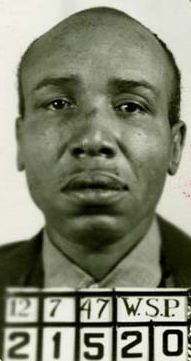Jake Bird
Jake Bird (December 14, 1901 – July 15, 1949) was an American self-confessed serial killer who was tried and executed for the axe murders of Bertha Kludt (age 53) and her daughter Beverly June Kludt (17) in Tacoma, Washington on October 30, 1947. Bird may have killed as many as 46 people.
Jake Bird | |
|---|---|
 December 7, 1947 Washington State Penitentiary Mugshot (Washington State Archives) | |
| Born | Jake Bird December 14, 1901[1] |
| Died | July 15, 1949 (aged 47) |
| Cause of death | Hanging |
| Other names | The Tacoma Ax-Killer |
| Conviction(s) | Murder |
| Criminal penalty | Death |
| Details | |
| Victims | 2 confirmed, suspect that he killed more than 40 people or even more |
Span of crimes | 1930–1947 |
| Country | United States |
| State(s) | Various |
Date apprehended | October 30, 1947 |
In 1991 criminologist Eric W. Hickey, Ph.D, Director of Alliant International University's Center for Forensic Studies, wrote about how the Bird case challenges stereotypes of serial killers, who are mostly thought to be Caucasian males, whereas African-American killers typically are associated with urban violence. Hickey wrote, "Revelations that Jake Bird, a black man, had actually stalked and killed dozens of white women in the 1940s in dozens of states...continue[s] to challenge traditionally held profiles of serial killers."[2]
Background
The 45-year-old Bird was a transient who had been born in Louisiana in a location he could not remember. He supported himself as a manual laborer and railroad gandy dancer, who laid and maintained tracks. The work on the railroad kept him moving from place to place.[3] He had an extensive criminal record, including burglary and attempted murder, and had been incarcerated for a total of 31 years in Michigan, Iowa and Utah.[4]
The Bird hex
After his conviction was announced, Bird was allowed to make a final statement. He spoke for 20 minutes, noting that his request to represent himself had been denied and that his own lawyers were against him.[5]
Bird then said, "I'm putting the Jake Bird hex on all of you who had anything to do with my being punished. Mark my words, you will die before I do." Allegedly, six people connected with the trial died: Judge Edward D. Hodge of a heart attack within a month of sentencing him to death, as did one of the officers who took his first confession. A police officer who took a second confession died, as did the court's chief clerk, and one of Bird's prison guards.[6] J.W. Selden, one of Bird's lawyers, died on the first anniversary of his sentencing.[7]
Reprieve, appeals and execution
The execution at the Washington State Penitentiary was scheduled for January 16, 1948, but Bird claimed he had committed 44 other murders which he was willing to help the police solve. Washington governor Monrad C. Wallgren granted him a 60-day reprieve. Police from other states interviewed Bird, and eleven murders were substantiated. He was knowledgeable enough about the 33 other murders to be considered a prime suspect.[8][9]
The interviews with Bird enabled the police departments of many states to declare many unsolved murders as solved. In addition to his Washington state murders, the transient Bird apparently had killed people in Florida, Illinois, Iowa, Kansas, Kentucky, Michigan, Nebraska, Ohio, Oklahoma, South Dakota and Wisconsin. He mostly preyed on Caucasian women. Bird had dispatched his victims with an axe or hatchet.[10][11]
During his reprieve, Bird lodged an appeal but a retrial was denied by the Washington State Supreme Court. His appeals to the federal courts, including three petitions to the United States Supreme Court, also were denied. He was hanged on the morning of July 15, 1949, at 12:20 a.m., before 125 witnesses. He was buried in an unmarked grave in the prison cemetery.[5]
References
- Newton, Michael (1990). Hunting Humans: An Encyclopedia of Modern Serial Killers. Loompanics Unlimited. ISBN 9781559500265.
- Hickey, Eric W. (2009). Serial Murderers and their Victims, 5th Edition. Wadsworth. p. 191. ISBN 978-4-95600814-3.
- "Bird, Jake". CrimeZZZ.net. Retrieved March 24, 2012.
- Nash, Jay Robert (1990). Encyclopedia of World Crime: A-C. p. 373. ISBN 978-0923582012.
- Davis, Jefferson (2008). Weird Washington: Your Travel Guide to Washington's Local Legends and Best Kept Secrets. Sterling. p. 216. ISBN 978-1402745454.
- "July 15th; 15/7/1949; Jake Bird – USA". True Crime Library. Archived from the original on December 2, 2010. Retrieved March 24, 2012.
- Nash. p. 374. Missing or empty
|title=(help) - Schechter, Schechter (2003). The Serial Killer Files: The Who, What, Where, How, and Why of the World's Most Terrifying Murderers. New York: Ballantine Books. pp. 149. ISBN 978-0345465665.
- Wolcott, Martin Gilman (2004). The Evil 100. Citadel. p. 129. ISBN 978-0806525556.
- Schechter, Schechter (2003). The Serial Killer Files: The Who, What, Where, How, and Why of the World's Most Terrifying Murderers. New York: Ballantine Books. pp. 149. ISBN 978-0345465665.
- Wolcott, Martin Gilman (2004). The Evil 100. Citadel. p. 129. ISBN 978-0806525556.